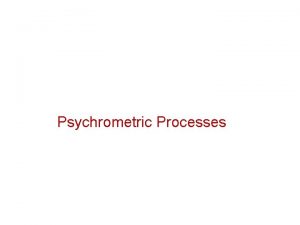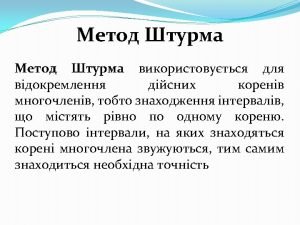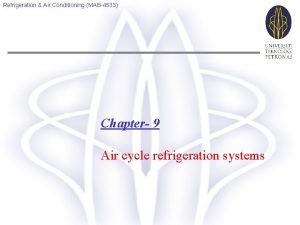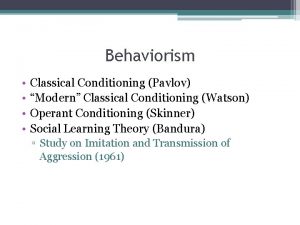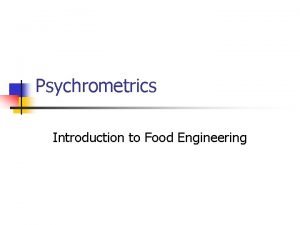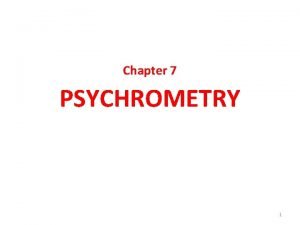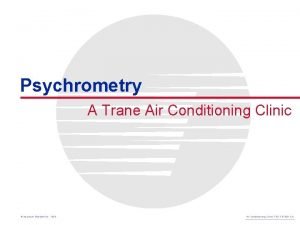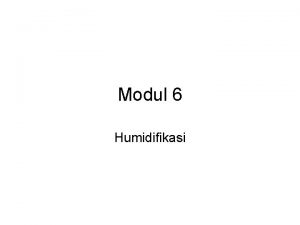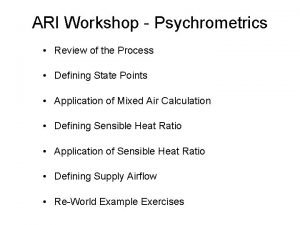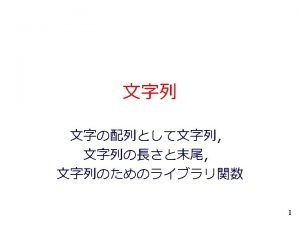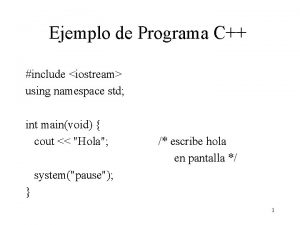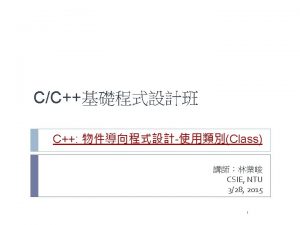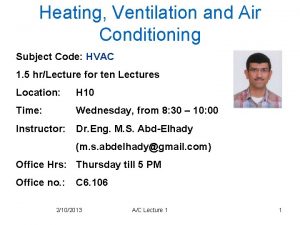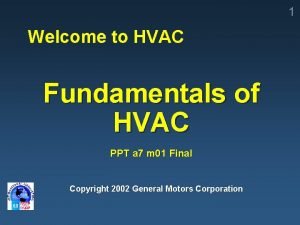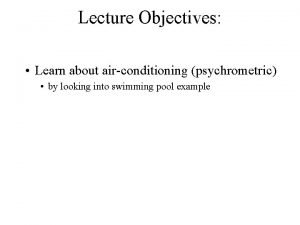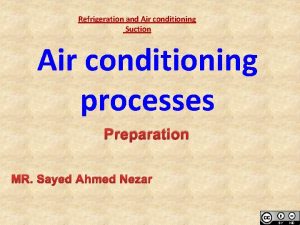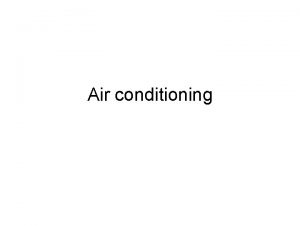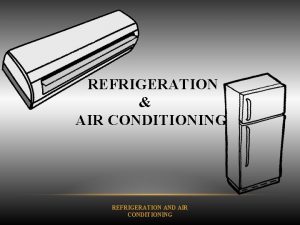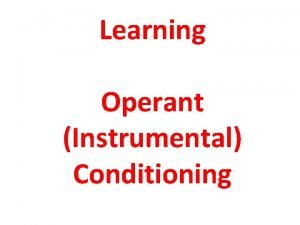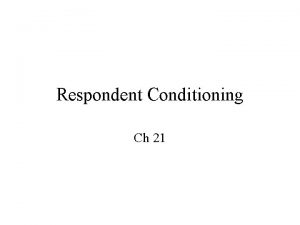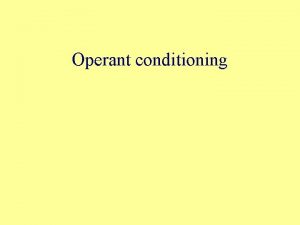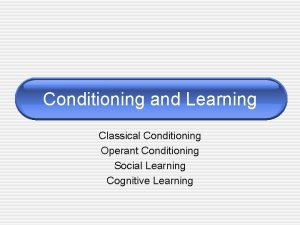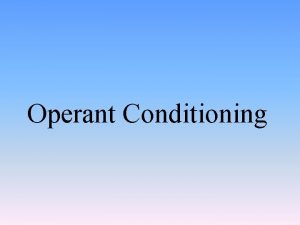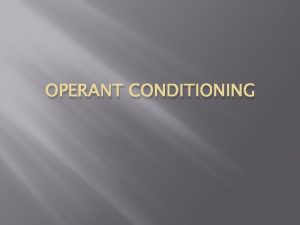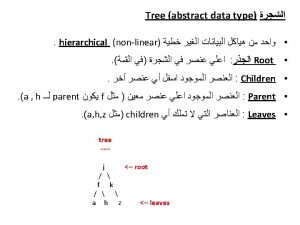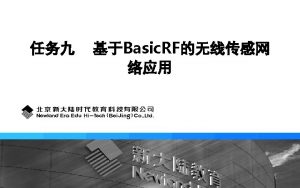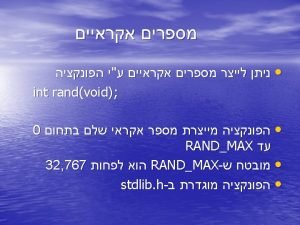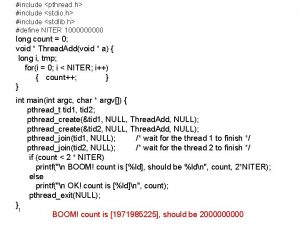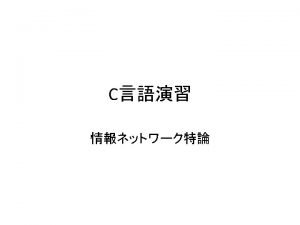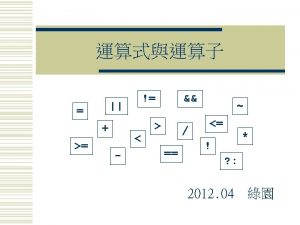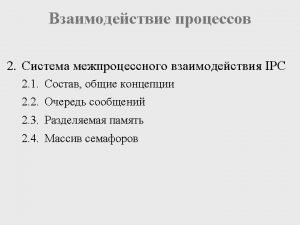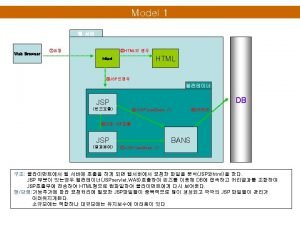Psychrometric Processes Air Conditioning Processes Airconditioning processes include




































- Slides: 36

Psychrometric Processes

Air – Conditioning Processes Air-conditioning processes include: Ø Simple heating (raising the temperature), Ø Simple cooling (lowering the temperature) Ø Humidifying (adding moisture), and Ø Dehumidifying (removing moisture).


Psychrometric Chart : • The properties of atmospheric air at a specified total pressure are presented in the form of easily readable charts called Psycrometric Chart. • The dry – bulb temperature are shown on the horizontal axis. • The specific humidity is shown on the vertical axis. 4

The psychrometric chart Enthalpy F Wet Bulb & Saturation Curve G D Dew Point E D Relative Humidity A Absolute Humidity Axis B Specific Volume C Dry Bulb Axis 5

• For a saturated air, the dry – bulb, wet – bulb and dew – point temperature are identical. 6

Constant RH% Lines Schematic of a psychrometric chart for a given barometric pressure 7

8

a) Sensible heating (Process O-B): During this process, the moisture content of air remains constant and its temperature increases as it flows over a heating coil. The heat transfer rate during this process is given by: Cpm = Sp. Heat of moist air


1. Define BPF. It’s relationship with effectiveness of coil. 2. What is heating capacity of coil?

b) Sensible cooling: During this process, the moisture content of air remains constant but its temperature decreases as it flows over a cooling coil. For moisture content to remain constant, the surface of the cooling coil should be dry and its surface temperature should be greater than the dew point temperature of air. If the cooling coil is 100% effective, then the exit temperature of air will be equal to the coil temperature. However, in practice, the exit air temperature will be higher than the cooling coil temperature. The heat transfer rate during this process is given by:


Simple Heating and Cooling (ω = constant) • There is no change in the absolute humidity of the air-vapor mixture. • Cooling occurs from right to left. • Heating occurs from left to right. • There is a change in the sensible heat of the air-vapor mixture. • Heat must be added or subtracted to cause the temperature change. Cooling Heating Dry Bulb Temperature

Humidification and dehumidification Process: 1. Show it on Psychrometric Chart. 2. How to achieve these processes? 3. How to determine LH added in these processes?

QL = Latent Heat Transfer


When moist air is cooled below its dew-point by bringing it in contact with a cold surface as shown in Fig. , some of the water vapor in the air condenses and leaves the air stream as liquid, as a result both the temperature and humidity ratio of air decreases as shown. This is the process air undergoes in a typical air conditioning system.




Summer cooling and dehumidification processes: 1 - All outside air , 2 - All return air , 3 - Mixing of fresh air with return air : as shown in the figure below. Sensible Heat Ratio ( SHR ) = Sensible heat/Total heat SHR = Qs /(Qs+Q By Pass Factor (BPF) : Is the factor that determine the quantity of air that by pass the cooling coil with out contacting its surfaces. BPF =( Ts – TADP) / (Tr – TADP ) Where TADP is the apparatus dew point temperature of the cooling coil.

Evaporative Cooling/ Adiabatic Cooling • Evaporative cooling is based on a simple principle: As water evaporates, the latent heat of vaporization is absorbed from the water body and the surrounding air. And both the water and the air are cooled during the process.

• During evaporative cooling the wet bulb temperature remains constant.

Heating with Humidification

d) Chemical Dehumidification Process

Adiabatic Mixing of Air streams • When two airstreams at two different states (states 1 and 2) are mixed adiabatically, the state of the mixture (state 3) will lie on the straight line connecting states 1 and 2 on the psychrometric chart, and the ratio of the distances 2 -3 and 3 -1 is equal to the ratio of flow rates and.

H 3 = m 1 h 1 + m 2 h 2 -----------------; m 1+m 2 Similarly for v 3 and w 3

e) Mixing of Two Air Streams without condensation

Air Washers:

Air Washers: An air washer is a device for conditioning air. As shown in Fig. , in an air washer air comes in direct contact with a spray of water and there will be an exchange of heat and mass (water vapour) between air and water. The outlet condition of air depends upon the temperature of water sprayed in the air washer. Hence, by controlling the water temperature externally, it is possible to control the outlet conditions of air, which then can be used for air conditioning purposes.




a) Cooling and dehumidification: tw < t. DPT. b) Adiabatic saturation: tw = t. WBT. c) Cooling and humidification: t. DPT < tw < t. WBT. d) Cooling and humidification: t. WBT < tw < t. DBT. e) Heating and humidification: tw > t. DBT.

 In chemical dehumidification process
In chemical dehumidification process #include stdio.h #include conio.h #include stdlib.h
#include stdio.h #include conio.h #include stdlib.h #include stdio.h int main()
#include stdio.h int main() Air cycle refrigeration
Air cycle refrigeration Operant conditioning classical conditioning
Operant conditioning classical conditioning Different types of reinforcement schedules
Different types of reinforcement schedules Operant vs. classical conditioning
Operant vs. classical conditioning Classical conditioning vs operant conditioning
Classical conditioning vs operant conditioning Classical vs operant conditioning
Classical vs operant conditioning Classical conditioning
Classical conditioning Classical conditioning vs operant conditioning
Classical conditioning vs operant conditioning Little albert experiment
Little albert experiment Operant conditioning vs instrumental conditioning
Operant conditioning vs instrumental conditioning Fixed interval schedule example
Fixed interval schedule example Air higroskopis adalah
Air higroskopis adalah Application of psychrometric chart in food processing
Application of psychrometric chart in food processing Psychrometry is the study of
Psychrometry is the study of Trane psychrometric chart pdf
Trane psychrometric chart pdf Contoh soal psychrometric chart
Contoh soal psychrometric chart Sensible heat ratio psychrometric chart
Sensible heat ratio psychrometric chart #include iostream #include string using namespace std
#include iostream #include string using namespace std Iostream in c++
Iostream in c++ #include iostream #include cmath
#include iostream #include cmath Namespace string
Namespace string Include stdio.h
Include stdio.h Include stdlib.h
Include stdlib.h Que significa #include iostream en c++
Que significa #include iostream en c++ Using namespace std
Using namespace std #include stdlib.h
#include stdlib.h Cppinclude
Cppinclude #include iostream #include string
#include iostream #include string Lillian purchased a guitar from smash
Lillian purchased a guitar from smash Refrigeration cycle ts diagram
Refrigeration cycle ts diagram Principles of air conditioning ppt
Principles of air conditioning ppt
